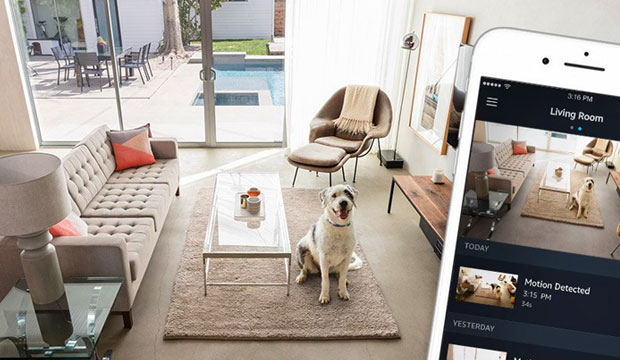Amazon on Wednesday began shipping its latest smart home product, a security camera that works with its Alexa personal assistant and Echo speakers.
The Amazon Cloud Cam allows customers to live-stream activity inside their home 24/7. It features 1080p full HD resolution, two-way audio for communicating with family members or pets, night vision technology, and sophisticated algorithms that use machine learning to figure out if the stranger entering your house is the building super or a possible burglar.
The smart cam, which retails for US$119.99, is incorporated into Amazon Key, which raised a ruckus upon its introduction late last month. The system allows drivers to open the doors of Prime members who want to have packages left inside their homes.
Delivery Watch
Customers using the Amazon Key program will need a compatible smart lock from Yale or Kwikset that allows delivery drivers to enter the home during a specified delivery time window. Users can watch as the driver opens the door, sets the delivery inside, and closes the door.
Amazon plans to coordinate the secure home entry system with more than 1,200 different service and delivery companies, including Merry Maids and Rover.com dog walkers.
“Intelligent home security devices are likely to disrupt the traditional home security monitoring industry over the next few years,” said Andrew Howard, chief technology officer at Kudelski Security.
“Paying for remote physical security monitoring may soon be a relic of the past, as consumers can save money and often receive better service while maintaining the same piece of mind with many of the same home security devices being offered by companies like Amazon and Google,” he told TechNewsWorld.
The Amazon Cloud Cam uses the Alexa voice technology to connect with smart speakers like the Echo Show and Echo Spot, as well as Amazon Fire TV devices and Fire tablets, to let users see who is inside or entering their home.
Users can watch the video feed from anywhere in the home using one of those devices, or they can watch remotely on their mobile devices using an iOS or Android app. When users are away from home, the Cloud Cam can be set up to send notifications to their phones, alerting them when motion is detected.
For an additional subscription, Amazon will support additional cameras in the home and provide increased storage and unlimited downloads. The subscription also allows for person detection, a way to flag human activity inside the home.
The machine learning technology can tell when the motion is caused by something expected, like a pet, or by something unexpected — like an intruder.
There is a growing market for automated home security cameras, with more than 90 different makers around the world shipping about 10,000 units per year, noted Blake Kozak, principal analyst for smart home and security technology at IHS Markit.
The market in the U.S. is currently estimated to be worth about $460 million, and has grown about 13 percent from a year ago, he told TechNewsWorld.
Amazon introduced the Cloud Cam as a way to build out its home automation ecosystem, Kozak said. Given the company’s expanding grocery business and the $13 billion acquisition of Whole Foods, this likely is just the beginning of the process.
“That’s really going to really let Amazon deliver a more customized home experience,” he said.
Featured Rivals
Rival devices from Nest and other firms offer higher-end technology than the Amazon Cloud Cam. For example, the Nest Cam IQ includes SuperSight technology, a 4K sensor with HDR, close-up tracking, familiar face alerts with a NestAware subscription, noise cancellation and echo suppression.
Integration with Google Home is slated for this winter, and the company plans to introduce Nest Hello video doorbells by 2018.
Nest recently introduced the Nest Secure alarm system, which includes motion detectors, voice control, and optional remote security monitoring.
Despite the increasing activity, the smart home camera’s impact on the home security market likely will be limited until the devices’ capabilities expand, suggested William Malik, vice president for infrastructure strategies at Trend Micro.
“Amazon’s weakness in the home security market is the absence of a real person to speak with,” he told TechNewsWorld.
Intrusive Tech
Despite the increasing interest in these devices, privacy advocates have expressed concerns about the risk to consumers — who might lose control over their private information — versus the benefit of having these devices in their home.
The Electronic Privacy Information Center two years ago asked the Federal Trade Commission to investigate Alexa voice technology, and asked the Department of Justice whether such listening devices violated provisions of federal wiretapping laws. Some privacy advocates feared Alexa was monitoring users’ everyday activities.
“A lot of tech experts are expressing serious skepticism about [Internet of Things] in the home,” Marc Rotenberg, executive director of the Electronic Privacy Information Center, told TechNewsWorld. “The benefits are overstated, and the risks are substantial.”






















































